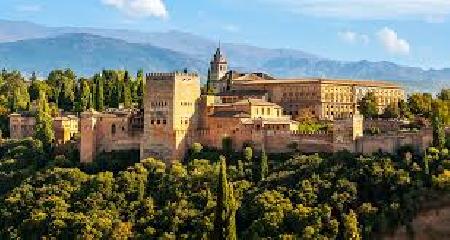 The Alhambra is a palace that functioned as a fortress in southern Spain, which was built during the Islamic era in Granada. Now it is a museum, one of the most famous and most visited places in Spain.
The Alhambra is a palace that functioned as a fortress in southern Spain, which was built during the Islamic era in Granada. Now it is a museum, one of the most famous and most visited places in Spain.
Originally it was built as a palace, woven from light and water, it was built for pleasure and rest, but for many centuries it belonged to Muslims, then it was a neighborhood in the medina, the Alhambra was rebuilt into a large fortified palace towards the end of the Moorish era on Spanish soil. The beautiful architecture of the complex after the restoration of the XIX-XX century allowed the palace to become one of the Spanish places of interest, a pearl of Moorish architecture.
The first builder of the palace was Muhammad I, the founder of the Nasrid dynasty. The motto of this warrior was "There is no God but Allah", and these writings are often found on the walls of the palace.
The Alhambra was inspired by the descriptions that the Koran makes about paradise, each of these descriptions has its representations in the sources and paths that exist within the palace. Patios, reception rooms, fountains and gardens, ponds and ponds, at first it seems that they are arranged randomly and intertwined, but in reality the complex is built in such a way as to make it seem that its inhabitants seem to be in a paradise where light, beauty, sky and shine are around.
In 1492, when the Spanish conquered Granada, the Alhambra became the residence of the Catholic Monarchs Isabel and Fernando. The city was under siege for three years. Legend has it that Queen Elizabeth swore that she would not wash until Granada fell.
The Emir of Granada, when forced out of the Alhambra, wept. Then his mother said to him, "Don't cry like a child so you couldn't defend like a man."
The palace was badly damaged, many symbols that decorated the walls and vaults were destroyed, and attempts were made to erase the Islamic calligraphy that existed. But even this could not disturb the beauty and harmony of this lace flower.
In the 19th century, the palace was in total desolation when Washington Irving came to Granada because the Alhambra was in its worst condition.
The Spanish had already abandoned it, and Napoleon's troops in 1812 blew up some of the buildings. The Alhambra became the place where several beggars slept, who settled within the walls of this place that was once considered a heavenly place.
But once again, beauty saved the palace from destruction. Several writers and poets, such as the aforementioned Washington Irving, Byron, Hugo, sang the beauty of this forgotten and abandoned place and sparked public interest in its history.
Fortunately, restoration work has restored the Alhambra to its former glory.
Today, the Alhambra has been transformed into an architectural and park complex, including a fortress, palaces with museums, and the Alhambra gardens. The popularity of the Alhambra is at its peak, receiving more than 2 million people who come to visit each year.
Address: Calle Real de la Alhambra, s / n, 18009 Granada, Spain
Telephone: +34 958 02 79 71
From October 15 to March 31, entry restricted to 6,300 people. Monday to Sunday from 8:30 a.m. to 6:00 p.m. Night visit: Friday and Saturday from 8:00 p.m. to 9:30 p.m. (Nasrid Palaces only). Closed: December 25 and January 1. From April 1 to October 14, entrance restricted to 7,700 people daily. Monday to Sunday from 8:30 a.m. to 8:00 p.m. Night visit: Tuesday to Saturday from 22:00 to 23:30 (Nasrid Palaces or Generalife Gardens).
